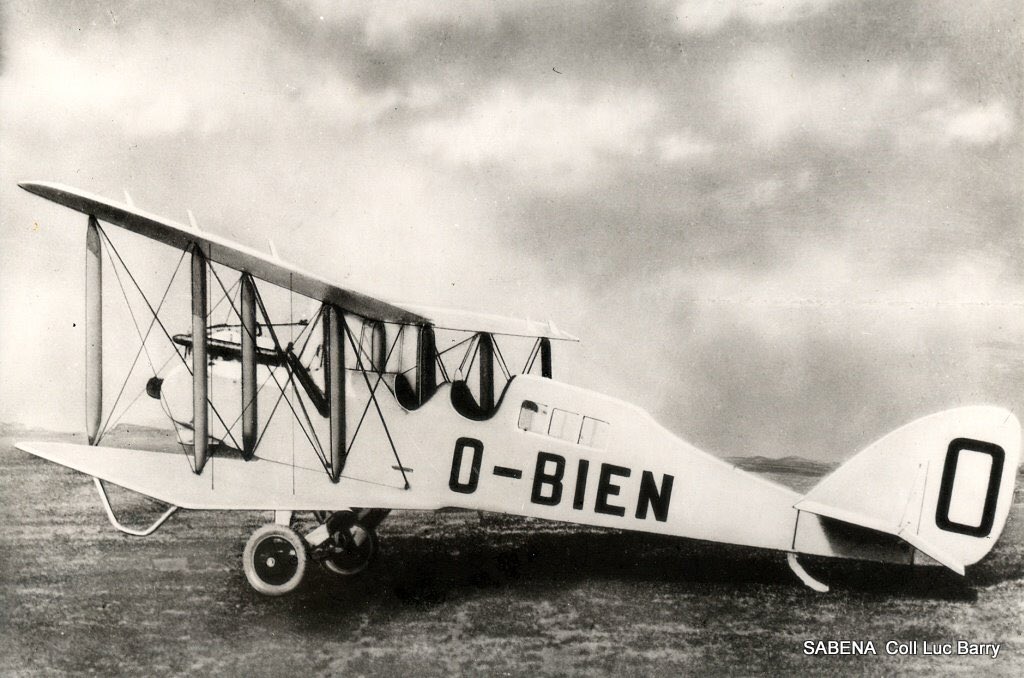
Exactly 100 years ago, on 23 May 1923, Sabena was founded by the Belgian government. The national carrier of Belgium took over the fleet of SNETA, a project company to investigate the need for commercial air traffic, consisting of four De Havilland DH.9, three Rumpler C.IV, one De Havilland DH.4, four Blériot-SPAD S.33, one Ansaldo A.300C and one Farman F.60 Goliath.
The same day, Sabena carried out her first flight, a mail and freighter flight between Haren (a former military airfield and civil airport near Brussels) and Lympne, United Kingdom with a stopover in Ostend, operated by a De Havilland DH.9
Exactly 100 years ago, May 23 1923, Sabena was founded! Aviation history was made and the airline embarked on an 8 decade journey. The very same day the first flight, operated by a DeHavilland DH9, took off from Haeren near Brussels, via Ostend, to Lympne in the U.K. #sabena100 pic.twitter.com/V4B8pIgyxn
— sabena (@fly_sabena) May 22, 2023
On 1 April 1924, the airline operated her first commercial flight between Rotterdam, The Netherlands and Straatsburg, France via a stopover in Brussels. The next years, more destinations are flown: Basel, Switzerland and London, United Kingdom.
From 1925, Sabena started to explore flights to the former Belgian colony of the Congo, now the Democratic Republic of the Congo. On 12 February 1925, Edmond Thierry, Léopold Roger and Jef de Bruycker started an arduous 51-day journey with a Handley Page W8, christened Princesse Marie-José, to Leopoldville, present Kinshasa.
On 23 February 1931, flights towards Leopoldville took only five days. To date, Kinshasa is still a key destination for private company and Lufthansa subsidiary (SN) Brussels Airlines.
Connecting Belgian Congo was a goal from the very beginning of Sabena. On February 12, 1925 Edmond Thierry, Léopold Roger and Jef de Bruycker started an arduous 51 day journey with a Handley Page W8, christened Princesse Marie-José, to Leopoldville, present Kinshasa #sabena100 pic.twitter.com/L340uRoUD1
— sabena (@fly_sabena) May 23, 2023
World War II severely disrupted Sabena’s operations. In May 1940, German forces invaded Belgium, and the airline’s fleet was grounded. Sabena’s aircraft were eventually requisitioned by the Germans, and the company’s facilities were used for military purposes.
After the war, Sabena faced significant challenges, including the need to rebuild its fleet and infrastructure. Despite the difficulties, the airline resumed services and gradually expanded its network, focusing on both European and intercontinental routes.
Sabena experienced substantial growth during the 1950s and 1960s. It introduced jet aircraft into its fleet, such as the Sud Aviation Caravelle and Boeing 707, allowing for faster and more comfortable long-haul travel. Sabena became known for its high-quality service and attention to passenger comfort.
In 1971, Sabena underwent a significant transformation when the Belgian government privatised the airline. The move aimed to increase efficiency and improve profitability. Sabena faced increased competition from other European carriers, but it continued to expand its fleet and modernise its operations.
The airline extended its intercontinental network to destinations in Africa, the Americas, Asia, and the Middle East. Sabena also developed strategic partnerships with other airlines to expand its reach further.
The 1990s brought both opportunities and challenges for Sabena. The liberalisation of the European aviation market led to increased competition, prompting the airline to adjust its business strategy. Sabena formed the Qualiflyer Group in 1997, a strategic alliance with Swissair and several other European airlines, to enhance its competitiveness.
Bankruptcy in 2001
Sabena (Société Anonyme Belge d’Exploitation de la Navigation Aérienne) was a venerable old lady of 78 years. An internationally renowned company, the largest employer with 10,000 workers, 11 million passengers in 2000, 107 destinations in 48 countries. That’s the positive business card.
But Sabena was also known for its losses almost every year. The lack of vision of the state, which regained control before the evil marriage with Swissair in 1995. A lack of capital, a hectic social life, a growing debt of two billion euros at the end. Especially after Swissair has undertaken to take the best, pumping subsidiaries and passengers, with a certain folly sometimes, as with the massive purchase of 34 Airbus aircraft, which put the balance sheet definitively in the red. A bankruptcy was declared on 7 November 2001.
The bankruptcy of Sabena had a significant impact, leading to the loss of thousands of jobs and leaving a void in Belgium’s aviation landscape. Today, the legacy of Sabena lives on in the memories of those who flew with the airline and in the history of Belgian aviation.



[…] Sabena was born on 23 May 1923. Despite the demise of the company in November 2001, many people and organisations wanted to commemorate the event, the creation of one of the very first airlines in the world. Therefore, the Royal Mint of Belgium issued a 20-euro coin made of 925/1000 silver. […]